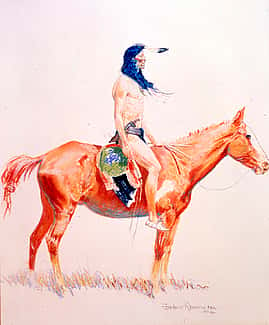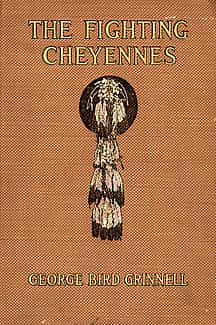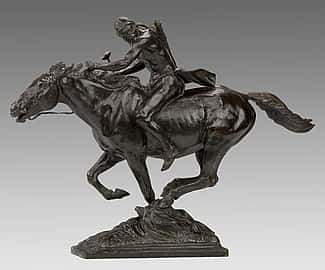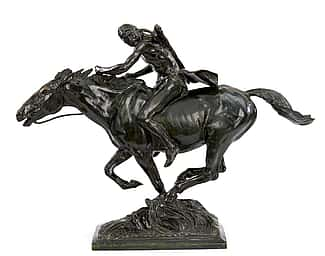
Pursued 2
Pursued
Indian Pursued; Pursued: Cheyenne Indian; The Pursuit
In 1900, while Proctor was focused on his remarkable creations as an animalier sculptor, his contemporary, the western painter and sculptor Frederic Remington, embarked on a series of works in several media devoted to some of the most acclaimed residents of the Northern Plains, the Cheyenne Indians. He first published a set of eight dramatic pastel drawings known as A Bunch of Buckskins, one of the highlights of which he titled A Cheyenne Buck.[Fig.1] It reflected the idealized and majestic pose rather similar to that which Proctor had chosen for his Indian Warrior a few years earlier.

A Cheyenne Buck, 1901
Pastel on academy board, 33 x 24 1/4 in.
National Cowboy & Western Heritage Museum,
Oklahoma City, Oklahoma. A.90.2
Another Remington interpretation of the Cheyenne people appeared as a bronze by that title in 1902, The Cheyenne. [Fig. 2] As opposed to being idealized, though, this rendition presented a Cheyenne warrior as animated and defiant. Every movement of man and horse in the sculpture reinforced the expression on the warrior’s face, a rebellious grimace charged with emotional symbolism that cried out for cultural survival. He was the exemplar of resistance, an emblem of male pride and bellicosity. A couple of years earlier, Remington had written his last major piece of fiction, a novel about a Cheyenne family that he titled The Way of an Indian. Not published until 1906, it bore the same message of cultural conflict and struggle.1 In it, Remington strove to present what he saw as the true Indian story. It was a heartbreaking tale of primal man against pernicious civilization, of tragic human loss and the dissolution of generations of cultural legacy. Remington’s friend and admirer, President Theodore Roosevelt, praised the author for revealing a convincing “understanding” of the Indian in the book’s pages.2

The Cheyenne, ca. 1905
Bronze, 22 1/2 in. (height)
Buffalo Bill Center of the West,
Cody, Wyoming.
Gift of Mrs. Henry H.R. Coe. 17.71
Another writer of the time, Proctor and Roosevelt’s friend and fellow Boone and Crocket Club member, George Bird Grinnell, was gaining fame for his informed and sympathetic treatise on the Cheyenne people that would appear in print as The Fighting Cheyennes in 1915.3 [Fig. 3] In that volume, he felt he could expose the true nature and history of the venerated Plains tribe by basing his research on direct Cheyenne interviews. Grinnell eschewed the standard U.S. military’s accounts of the Anglo/Indian encounters in the West and relied instead on the Indian perspective.

The Fighting Cheyennes, 1915
Front cover of book
McCracken Research Library,
Buffalo Bill Center of the West,
Cody, Wyoming. E99.C53 G8 191
One of the Cheyenne leaders who played a primary role in Grinnell’s book was a warrior chief named Little Wolf. Grinnell devoted one whole chapter to Little Wolf’s leadership in the arduous and powerfully symbolic 1879 venture of moving his people from Indian Territory, Oklahoma, where they had been forcibly relocated, back to their ancestral home in the Powder River country of Montana. He and his band literally fought their way north, battling multiple U.S. military forces a long the way and ultimately surrendering to Captain W.P. Clark, an old friend of Little Wolf and an emissary of General Nelson Miles. Little Wolf and his people ended up on the Cheyenne Reservation near Lame Deer, Montana, making the trip’s travails worth the effort. Though diminished in strength and numbers, they were home at last.
Little Wolf died in 1904, but Grinnell’s telling of his life, as one of the truly great men of Plains Indian history, sustained his legendary reputation.4 There is no specific evidence that Grinnell and Proctor discussed Little Wolf or even the Cheyenne Indians. Yet, the fact that Proctor in 1915 decided to venture west in search of worthy human subjects and found his inspiration on the Cheyenne Reservation with the chief’s nephew, Laban Little Wolf, suggests that the author and the artist had probably conversed on the matter. Laban’s son, Robert, became the primary model for Proctor’s sculpture Pursued, and that work was invested with a sense of destiny and flight that mirrors the plight of the Northern Cheyenne people and the dramatic tale of the model’s great uncle. Pursued can be presumed to be a metaphor for the Cheyenne Indians in their worthy yet perilous quest to find a well-deserved, compatible, and historically resonant homeland.
Proctor had known Grinnell at least since 1893 in Chicago when the artist was inducted into the Boone and Crockett Club and probably connected with him again in 1895 in Montana.5 They had much in common, both with the historic conservation organization and with Indians. Grinnell, in 1895, was working on the establishment of Glacier National Park but, as a student of the Blackfeet Indians, was in Montana also to visit the native people of the region. Proctor was on a hunting trip just outside the park’s future boundaries with his lawyer friend and fellow Boone and Crockett Club member, Henry L. Stimson. Proctor set aside extra time during his trip to visit the Blackfeet Reservation in search of a model for his first major work, Indian Warrior.

Pursued, ca. 1914–1922
Bronze, 18 1/2 in. (height)
The Rees-Jones Collection, Dallas, Texas
In 1908, Proctor provided the Boone and Crockett Club with its emblem, his Head of a Brown Bear. Members at that year’s annual dinner in New York were each given, as a favor, a plaster casting of the piece by the artist. Grinnell was in attendance at the dinner and, as chairman of the nominating committee, was an officer of the club. No doubt, their friendship would have been further cemented by Proctor’s generous gesture toward the club and his fellow wildlife conservationists.
Many years later, in his autobiography, Proctor referred to his intentions with Pursued. He said that he wanted to create an equestrian Indian being chased “by an unseen enemy.”6 Robert looks over his left shoulder, just as his great uncle had done many times in his attempts to escape from the U.S. Army. In order to add an extra element of peril, Proctor wanted his subject to appear to be running downhill, hence the elevated rump of the horse even though the ground seems only slightly sloped.7 The work is drama in action, giving a real sense of fright and desperation. It is the antithesis of Remington’s The Cheyenne in which the warrior is aggressive and frightful in his own right. Proctor’s work is fearful while Remington’s is adversarial. Proctor’s seems to project the Indian perspective much as Grinnell had, while Remington’s, given its vengeful countenance, rather justified the Anglo and military viewpoint that the Indian was a worthy adversary, but an adversary nonetheless.
There is another perspective that might be considered as well when comparing Remington’s The Cheyenne and Proctor’s Pursued, and that involves the level of sculptural decorum that each represented. Both works were assessed in 1915, and the critical perceptions were strikingly disparate. Remington’s bronze was viewed as daring, rough, and controversial even
six years after his death. A casting of The Cheyenne was exhibited posthumously at the Panama-Pacific Exposition in 1915 and was considered by one critic, Eugen Neuhaus, as “lacking in repose” and “wild and ill-mannered” when compared with other works in the vast San Francisco display.8 At exactly the same time, Proctor’s Indian sculpture was regarded as the opposite. Canadian critic W. H. de B. Nelson wrote that “Proctor never wanders out of his way to compose some striking effect calculated to cause a sensation,” but rather stays within the “accepted canons of sculptural taste.”9 Proctor countered Remington’s brashness with propriety. As the Los Angeles Times would say a few years later, “Strength and delicacy, power and refinement, classic poise with modern freedom—these are the qualities of the sculptures of A. Phimister Proctor.”10
In his short lifetime, Remington produced as many as twenty casts of The Cheyenne. Proctor, over many more years and with two variations, cast somewhere close to the same number (sixteen are known today). There appeared to have been a modestly healthy appetite then for both versions of the Cheyenne rider.

Pursued, 1928
Bronze, 17 in. (height)
Smithsonian American Art Museum,
Washington, DC. Museum Purchase. 1992.
Actually there was more than one rider involved in the conceptualization of Proctor’s Pursued. Robert Little Wolf, the grand-nephew of the great chief of the same name, modeled through much of the summer of 1914. When Robert had to return to ranching obligations, Proctor was forced to find another young Cheyenne to pose. J.R. Eddy was the primary agent of the Cheyenne Reservation. It was Eddy who introduced Proctor to the Little Wolf family, and it was probably Eddy who found a substitute, a young graduate of the Carlisle Indian School, Rutherford Rolling Bull. Proctor commented that, like Robert, Rutherford “was willing to pose in a G-string and braids.” Rutherford persevered into the fall of the year, despite the “onset of cold weather,” and until the plaster was completed and sent from Montana to New York to be cast.11

Pursued (Comp. De Bronzes, detail – foundry mark), 1928
Bronze
Smithsonian American Art Museum,
Washington, DC. Museum Purchase. 1992.3
Proctor probably produced that first bronze cast in late 1914. It t was exhibited initially with five other bronzes in Seattle in the galleries of the Washington State Art Association the next July, and then travelled on a whirlwind tour to a private residence display in Portland, Oregon, and finally the Public Library in Pendleton.12
There were two different versions of this work. The first resulted directly from the artist’s experience with the models, Robert Little Wolf and Rutherford Rolling Bull. He had the models race down a hill past him until he was able to grasp the essence of interaction between horse and rider, and capture the speed and flow of the group. That version portrays the horse suspended on only one hoof galloping from right to left with the rider holding a spear and looking over his left shoulder. The horse’s rump is elevated, and the base extends beneath five-eighths of the length of the horse. The rear of the base is slightly raised, suggesting a lift in the ground that mirrors the heightened hind quarter of the horse or an object over which the horse has just jumped. As is normal with Proctor’s work, the figures are animated but graceful. Of the ten known castings of the first version, made between 1915 and 1928, all but two were cast by Roman Bronze Works in lost wax. [Fig. 4] The two exceptions are sand castings from Gorham Co. Founders. Proctor’s old friend Henry Stimson, Secretary of War for the Taft administration, purchased one of the Gorham casts as a gift for his aide de camp, Henry Regnier.

Pursued, ca. 1928
Bronze, 17 in. (height)
Buffalo Bill Center of the West,
Cody, Wyoming.
William E. Weiss Memorial Fund Purchase. 11.75
The second version of Pursued was initially modeled in Brussels over the winter of 1927 – 1928. The Proctors had settled in Brussels after several years in Rome. Mussolini was inciting riots in Italy, and the artist made a strategic retreat to Belgium before the situation became too volatile. Proctor moved into a comfortable studio there and, among other things, began reworking his Cheyenne rider sculpture. The first casting was produced there by the Comp. De Bronzes foundry in last wax. [Figs. 5 and 6] It showed a set of remarkable revisions that included a replacement of the spear with a war club, a quiver over the warrior’s shoulder, a lowering of the rider’s breechcloth and the horse’s rump, a shortening and reconfiguration of the base, and the addition of inclusive dates “1915 and 1928.”

Pursued (Gorham / Gargani, detail — foundry mark), ca. 1928
Bronze)
Buffalo Bill Center of the West,
Cody, Wyoming.
William E. Weiss Memorial Fund Purchase. 11.75
When Proctor and his family returned to the United States, it appears that he sent the new model to Gorham. By that date, Gorham was promoting its new use of the lost-wax process. One of the former employees of the Roman Bronze Works, Eugene Gargani, started subcontracting work for Gorham in 1928, just in time to accommodate Proctor and his newest sculpture. Gargani’s cast number 1, in cire perdue and carrying a Gorham Co. Founders mark, was probably produced that year under the Eugene Gargani & Sons contract. [Figs. 7 and 8] One of these late Gorham castings, a bronze that sold to Proctor’s friend, the oil magnate, George Dupont Pratt, and is now in the collection of the Mead Art Museum, came at a cost of $155 in 1932.13
By Peter H. Hassrick
Endnotes
- The book was published initially in serial form in The Cosmopolitan, __ (November 1905) to __ (March 1906). The book followed, The Way of an Indian (New York: Fox Duffield & Company, 1906).
- Letter from Roosevelt to Remington, February 20, 1906, quoted in Allen P. and Marilyn D. Splete, Frederic Remington—Selected Letters (New York, Abbeville Press, 1988), 359.
- George Bird Grinnell, The Fighting Cheyennes (New York: Charles Scribner’s Sons, 1915).
- Ibid, 427.
- Proctor mentions meeting Grinnell at the annual Boone and Crockett dinner in 1893Also see Ebner, Sculptor in Buckskin, 111 and 127.
- Ibid., 158.
- Ibid., 159.
- Eugen Neuhaus, The Galleries of the Exposition (San Francisco: Paul Elder and Company, 1915), 56.
- W.H. de B. Nelson, “Phimister Proctor: Canadian Sculptor,” The Canadian Magazine, 44 (April 1915), 500.
- “Proctor, A Sculptor of Unusual Power,” Los Angeles Times (April 1, 1923).
- Ebner, Sculptor in Buckskins, 162.
- See “Sculptor to Exhibit Small Bronzes Here,” Seattle The Post-Intelligencer (July 16, 1915), and Lilian Tingle, “Noted Sculptor, Now in Portland, Is Putting Cowboy on ‘Art Map’,” Portland Oregonian (July 25, 1915) and Pendleton Evening Tribune (September 17, 1915).
- Proctor’s Ledger Book, Proctor Papers, McCracken research Library, Buffalo Bill Center of the West.
